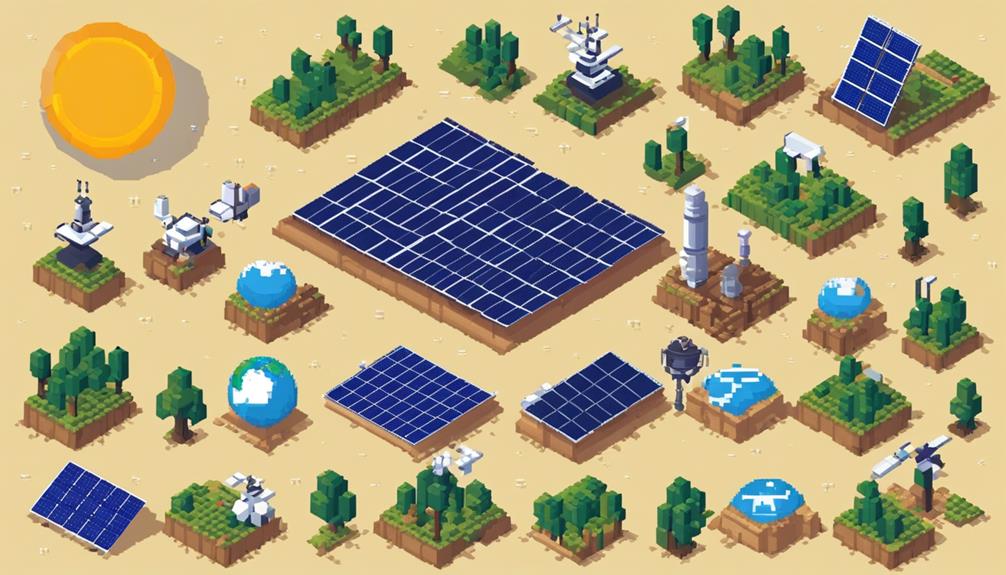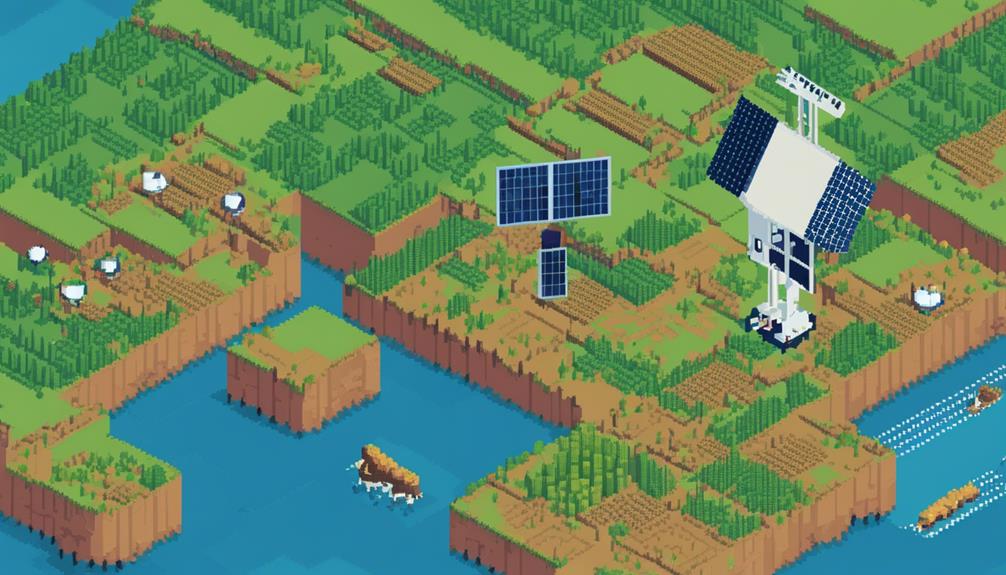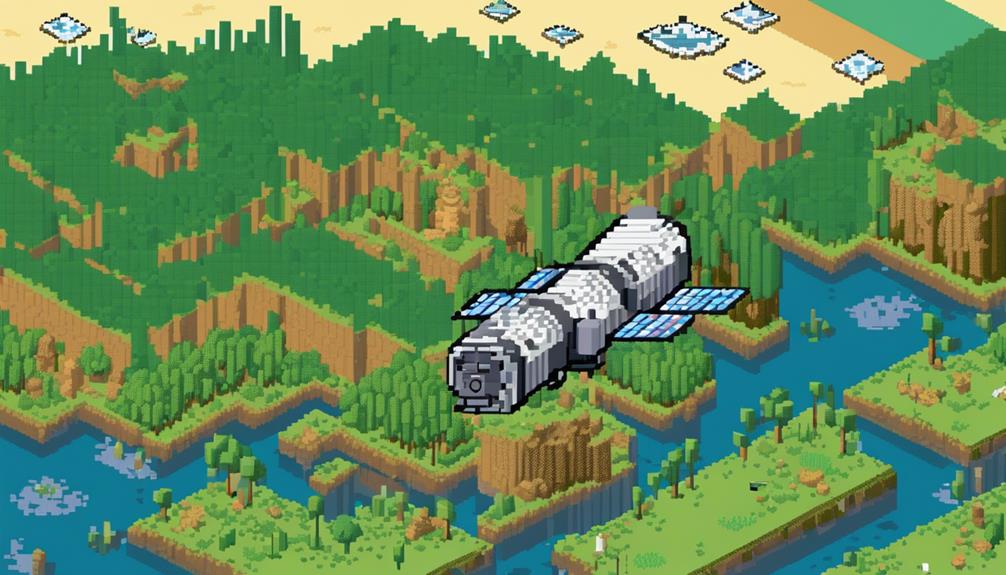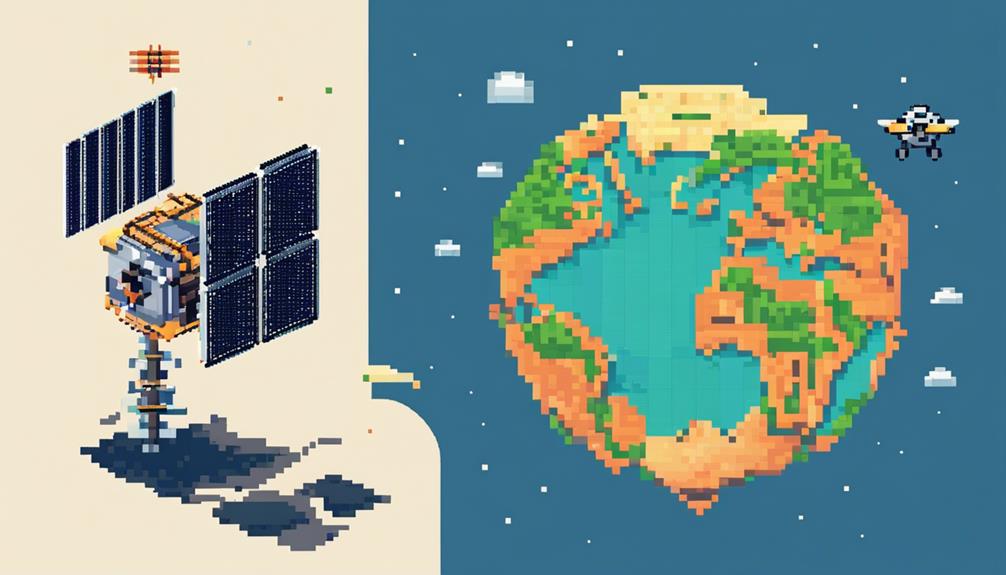Environmental monitoring satellites serve as essential instruments in the realm of sustainability, offering a non-intrusive means of observing and understanding our planet's intricate ecosystems from a vantage point beyond our atmosphere. By harnessing advanced remote sensing technologies, these satellites facilitate the acquisition of crucial environmental data crucial for informed decision-making. From deforestation patterns to climate fluctuations, the depth and breadth of information provided by these satellites are invaluable in driving sustainable practices and policies. The utilization of satellite data not only sheds light on environmental challenges but also propels the collective journey towards a more sustainable future.
Key Takeaways
- Environmental monitoring satellites offer crucial data for sustainability efforts and decision-making.
- They provide real-time insights for informed decision-making and continuous monitoring of ecosystems.
- Satellite data aids in climate analysis, ice melt tracking, and mitigation strategy development.
- These satellites support environmental protection, biodiversity conservation, and ecological impact assessments globally.
Importance of Environmental Monitoring Satellites

Why are environmental monitoring satellites indispensable tools in tracking crucial environmental indicators and phenomena? Environmental monitoring satellites play a pivotal role in providing valuable satellite data for tracking and analyzing various environmental factors, including greenhouse gases, climate change impacts, and deforestation. These satellites contribute significantly to sustainability efforts by offering essential information for decision-making processes aimed at mitigating environmental degradation and promoting sustainable practices.
Satellites equipped with advanced sensors enable the monitoring of greenhouse gases such as CO2 and methane on a global scale. This data is crucial for understanding the trends in greenhouse gas emissions, which are directly linked to climate change. By tracking these gases, environmental monitoring satellites help policymakers and researchers assess the effectiveness of climate change mitigation strategies and develop informed policies to combat global warming.
Moreover, environmental monitoring satellites are instrumental in tracking deforestation patterns and land use changes. By observing deforestation trends, these satellites aid in identifying areas at risk and monitoring the impact of human activities on forest cover. This information is vital for implementing measures to reduce emissions from deforestation and degradation, thereby promoting sustainable land management practices.
Validation and calibration of satellite data are essential to ensure the accuracy and reliability of the information gathered by environmental monitoring satellites. This validation process is critical for maintaining the integrity of the data used in environmental monitoring and sustainability efforts, allowing for informed decision-making and effective environmental management strategies.
Role in Global Sustainability Efforts
Environmental monitoring satellites play a critical role in conducting global impact assessments and tracking progress towards sustainable development goals. These satellites provide valuable insights into environmental changes, helping policymakers and organizations make informed decisions to promote sustainability. By monitoring key indicators such as deforestation rates and carbon emissions, these satellites contribute significantly to global efforts aimed at achieving long-term environmental sustainability.
Global Impact Assessment
Playing a pivotal role in evaluating global sustainability efforts, environmental monitoring satellites provide essential real-time data on environmental conditions. These satellites contribute significantly to global impact assessment by tracking changes in land use, vegetation cover, and carbon emissions to support sustainable development goals. By monitoring climate change impacts, deforestation trends, and biodiversity loss on a global scale, environmental monitoring satellites offer valuable insights for environmental conservation initiatives. The data obtained from these satellites aids in evaluating the effectiveness of conservation strategies and guiding policies for environmental protection. Overall, the role of monitoring satellites in global impact assessment is crucial for understanding the state of Earth's ecosystems and facilitating efforts towards achieving global sustainability targets.
Sustainable Development Tracking
In the realm of global sustainability efforts, environmental monitoring satellites play a crucial role in tracking progress towards sustainable development goals by providing essential data on environmental changes and human impact indicators. These satellites enable the monitoring of key indicators such as deforestation rates, carbon emissions, and land use changes, contributing to the assessment of the effectiveness of sustainability initiatives worldwide. By collecting and analyzing data over time, they support evidence-based decision-making and policy formulation for a more sustainable future. The data obtained from environmental monitoring satellites is instrumental in understanding the impact of human activities on the Global Earth and helps in shaping strategies to mitigate negative effects, ultimately working towards a more sustainable and environmentally conscious world.
Advantages of Satellite Data for Sustainability

Utilizing satellite data provides a valuable means of obtaining real-time insights essential for informed decision-making in sustainability initiatives. Satellite data offers a wealth of advantages for sustainability efforts, enabling monitoring of environmental changes, assessment of carbon emissions, and facilitation of conservation initiatives. Here are some key advantages of satellite data for sustainability:
| Advantages of Satellite Data for Sustainability | |
|---|---|
| 1. Real-time Insights | 2. Continuous Monitoring |
| Satellite data provides instant information on environmental parameters, aiding in quick responses to changes. | Satellite technology allows for the ongoing monitoring of ecosystems, helping in the early detection of issues. |
| 3. Detailed Analysis | 4. Enhanced Conservation Efforts |
| High-resolution satellite imagery offers in-depth analysis of land use, vegetation health, and carbon emissions. | Satellite data supports conservation efforts by providing accurate information for targeted interventions. |
Incorporating satellite data into sustainability practices not only helps in reducing carbon footprints but also optimizes resource management and fosters sustainable development. The utilization of satellite technology plays a crucial role in promoting global sustainability by providing accurate, up-to-date information for addressing environmental challenges effectively.
Monitoring Climate Change With Satellites
Satellites equipped with advanced sensors play a crucial role in analyzing temperature trends, tracking ice melt patterns, and monitoring weather changes. These capabilities enable scientists to gather valuable data on climate change impacts and assess the scope of environmental challenges. By leveraging satellite technology, researchers can enhance their understanding of how global warming is affecting the Earth's ecosystems and weather systems.
Temperature Trends Analysis
Tracking temperature trends globally with advanced satellite technology allows for accurate monitoring of climate change and its associated impacts. Satellites provide continuous data on temperature variations, enabling in-depth data analysis for understanding long-term climate patterns. By monitoring temperature trends with satellites, scientists can gain insights into temperature changes across different regions and over time, facilitating the prediction of climate-related events and the assessment of climate change effects. This data is crucial for developing effective mitigation and adaptation strategies to address the challenges posed by climate change. Utilizing satellite observations for temperature trend analysis enhances our ability to make informed decisions and take proactive measures towards sustainability.
| Advantages of Satellite Temperature Trend Analysis |
|---|
| Continuous data collection |
| Global coverage |
| Facilitates long-term climate pattern analysis |
| Enables prediction of climate-related events |
| Supports development of mitigation strategies |
Ice Melt Tracking
Monitoring ice melt through advanced satellite technology plays a crucial role in studying the impact of climate change on polar regions. Satellite observations provide vital data on ice melt tracking, offering insights into climate change impacts. Key aspects monitored include changes in ice extent, thickness, and movement over time. This information helps scientists understand the rate of ice loss and its contribution to sea level rise. Additionally, data from satellites aids in predicting future climate scenarios and assessing environmental risks associated with global warming. By utilizing satellite technology for ice melt tracking, researchers can better comprehend the changing dynamics of Earth's polar regions and the broader implications for our planet's sustainability.
Weather Pattern Monitoring
Weather pattern monitoring is a critical aspect of utilizing satellite technology to track and analyze climate change. Satellites play a crucial role in monitoring various aspects of climate change, including greenhouse gas monitoring, sea level rise observation, and wildfire monitoring. Precise climate change monitoring heavily relies on accurate validation and calibration of satellite data. For instance, satellites like Japan's Ibuki satellite provide global measurements of greenhouse gases, aiding in climate change analysis. Moreover, satellite data helps monitor deforestation trends to reduce emissions and mitigate climate change impacts effectively. By observing weather patterns and other climate change indicators from space, satellites offer valuable insights into the Earth's changing climate.
| Climate Change Monitoring | Satellite Technology |
|---|---|
| Greenhouse Gas Monitoring | Satellite Data Validation |
| Sea Level Rise Observation | Wildfire Monitoring |
Satellite Technology for Environmental Protection
Utilizing advanced satellite technology is instrumental in bolstering environmental protection efforts through comprehensive data collection and analysis. Environmental monitoring satellites play a crucial role in providing essential data for addressing global challenges related to climate change, deforestation, and biodiversity conservation. These satellites offer high-resolution satellite imagery, enabling continuous monitoring of Earth's surface to support sustainability efforts. Here are some key ways in which satellite technology contributes to environmental protection:
- Real-time Data: Satellites enable the collection of real-time data on environmental changes, allowing for immediate responses to emerging threats.
- Support for Sustainable Practices: By assessing the impact of human activities on the environment, satellites help in implementing and monitoring sustainable practices effectively.
- Monitoring Global Greenhouse Gas Emissions: Satellite technology aids in tracking global greenhouse gas emissions, providing valuable insights for climate change mitigation strategies.
- Data for Biodiversity Conservation: Environmental monitoring satellites offer vital information for biodiversity conservation efforts, helping in the preservation of ecosystems and species diversity.
Applications in Biodiversity Conservation

Satellite technology plays a pivotal role in facilitating the application of advanced methods for biodiversity conservation. By utilizing satellite images, experts can effectively monitor changes in vegetation, land use, and ecosystems on a large scale. This capability is particularly valuable in biodiversity conservation efforts in mining areas, where ecological impacts can be significant. Satellites provide crucial data that aids in tracking and analyzing the biodiversity impact of mining activities, ultimately assisting in the preservation of critical habitats. High-resolution satellite imagery offers a comprehensive view of biodiversity in these regions, enabling the development and implementation of targeted conservation strategies.
Moreover, satellite technology is instrumental in detecting and monitoring ecological impacts resulting from mining activities. By observing changes in vegetation, land cover, and overall biodiversity over time, satellites contribute significantly to biodiversity conservation efforts in mining areas. The data obtained through satellite monitoring ensures that sustainable practices are upheld, allowing for the mitigation of negative impacts on the environment. In essence, satellites serve as powerful tools in biodiversity conservation, providing essential information for making informed decisions and promoting the long-term sustainability of ecosystems in mining regions.
Enhancing Sustainable Practices Through Satellites
Enhancing sustainable practices through the utilization of satellite technology is imperative for effective environmental monitoring and resource management. Satellite technology offers a wide array of tools and benefits that contribute to a sustainable future:
- Real-time Data: Satellites provide crucial information on environmental changes, such as deforestation monitoring, enabling timely interventions to combat such activities.
- Carbon Emissions Insights: By offering insights into carbon emissions, satellites aid in making informed decisions aimed at reducing environmental impact and promoting sustainable practices.
- Precision Agriculture: Satellite data supports precision agriculture by providing farmers with valuable information to optimize resource use, leading to sustainable food production.
- Biodiversity Tracking: Monitoring tools on satellites help track biodiversity changes, particularly in mining areas, facilitating conservation efforts and promoting sustainable practices.
Satellite technology plays a pivotal role in enhancing sustainability by providing the necessary monitoring tools and data analytics to support various environmental initiatives. By leveraging the capabilities of satellites, stakeholders can make better-informed decisions that promote conservation, resource efficiency, and overall environmental sustainability.
Tracking Environmental Changes From Space

Environmental monitoring satellites play a crucial role in tracking environmental changes from space by monitoring global temperature trends, mapping deforestation patterns, and assessing ocean pollution levels. These satellites provide valuable data that aids in understanding the dynamics of environmental shifts and the impacts of human activities on the planet. Through precise observations, satellite technology contributes significantly to environmental conservation efforts and the development of sustainable practices worldwide.
Global Temperature Trends
Global temperature trends are meticulously tracked through the utilization of advanced satellite technology to monitor environmental changes on a global scale.
- Satellite data provides valuable insights into temperature variations across the Earth's surface.
- Continuous monitoring of global temperature trends aids in climate change analysis and modeling.
- Anomalies and patterns in temperature fluctuations worldwide are detected through satellite observations.
- Environmental monitoring satellites play a crucial role in understanding and addressing climate change impacts.
Deforestation Mapping
Satellite technology facilitates the accurate monitoring and mapping of deforestation, providing crucial insights into forest cover changes and land-use transformations over time. Through the utilization of satellite imagery and remote sensing technology, deforestation patterns, areas of forest loss, and land-use changes can be tracked with precision. This technology enables continuous monitoring to identify deforestation hotspots, aiding conservation efforts by directing attention to areas requiring immediate intervention. The data obtained from satellite monitoring also plays a vital role in biodiversity assessment, allowing for the evaluation of the impact of deforestation on ecosystems. By leveraging satellite technology for deforestation mapping, a comprehensive understanding of forest cover changes can be achieved, supporting sustainable environmental management practices.
Ocean Pollution Monitoring
Utilizing advanced remote sensing technology, monitoring ocean pollution from space provides crucial insights into the impact of contaminants on marine ecosystems and supports the development of targeted conservation strategies. Environmental monitoring satellites track ocean pollution levels by detecting oil spills, plastic debris, and other contaminants from space. These satellites capture high-resolution images, aiding in the identification of pollution sources and trends in the ocean. Satellite technology enables monitoring of coastal areas, shipping routes, and offshore platforms to detect and prevent environmental damage. Ocean pollution monitoring from space plays a vital role in developing effective strategies for conservation, sustainable resource management, and marine ecosystem protection.
Satellite Solutions for Ecological Impact Assessment

Employing cutting-edge remote sensing technologies, ecological impact assessment in mining areas is significantly enhanced through the utilization of satellite solutions. Satellite solutions provide invaluable data for monitoring land cover changes, vegetation health, and water quality in mining environments. These tools offer high-resolution imagery that enables the detection of ecological changes, supporting the identification of potential impacts caused by mining activities. By leveraging remote sensing technologies like satellites and drones, environmental experts can conduct comprehensive assessments to ensure sustainable mining practices.
To better illustrate the capabilities of satellite solutions for ecological impact assessment in mining areas, consider the following table:
| Satellite Solutions Features | Benefits |
|---|---|
| High-resolution imagery | Accurate monitoring of land cover changes |
| Vegetation health assessment | Detection of ecological impacts |
| Water quality analysis | Identification of environmental changes |
Coupled with data analytics platforms and AI algorithms, these satellite solutions empower decision-makers with the insights needed to promote sustainable mining practices. The integration of these technologies facilitates the efficient evaluation of environmental impacts, aiding in the development of strategies to mitigate adverse effects on ecosystems while ensuring the longevity of mining operations.
Promoting Green Initiatives With Satellite Monitoring
In advancing environmental stewardship practices within industrial sectors, the integration of satellite monitoring technologies plays a pivotal role in driving green initiatives through enhanced ecological oversight. Satellites offer a range of benefits that support sustainability efforts and promote environmental conservation:
- Satellite monitoring enables real-time tracking of environmental changes like deforestation, land use, and biodiversity to support green initiatives.
- It provides crucial data on carbon emissions, vegetation health, and climate variables for informed decision-making in sustainability efforts.
- Satellite technology offers comprehensive coverage of large areas, aiding in monitoring and mitigating ecological impacts of various industries.
- By facilitating precise monitoring of mining areas and ecological changes, satellites contribute to promoting sustainable practices and environmental conservation.
The high-resolution imagery from satellites supports efforts to optimize mining processes, reduce environmental footprint, and enhance biodiversity conservation. Industries can utilize this technology to make informed decisions that align with green initiatives, leading to a more sustainable future. Satellite monitoring not only enhances ecological oversight but also empowers businesses to implement practices that reduce their environmental impact, contributing to the overall goal of sustainability.
Frequently Asked Questions
How Can Satellites Be Used to Monitor the Environment?
Satellites, akin to vigilant sentinels in the sky, serve as indispensable tools for environmental monitoring. They meticulously track climate change, deforestation, pollution, water quality, wildlife conservation, urban sprawl, and agricultural practices. Through high-resolution imagery and data collection, satellites enable precise detection of ecological changes, contributing significantly to global sustainability efforts. Their role in monitoring key environmental indicators underscores their vital importance in safeguarding our planet's health and biodiversity.
How Do Satellites Help Sustainability?
Satellites contribute significantly to sustainability efforts by providing crucial data on climate change, deforestation tracking, water pollution, soil erosion, urban development, wildlife conservation, and air quality. These tools enable real-time monitoring and analysis, facilitating informed decision-making for conservation and mitigation strategies. Satellite technology aids in identifying environmental threats, evaluating ecosystem health, and guiding sustainable practices for a more resilient and sustainable future.
How Does Satellite Imaging Help the Environment?
Satellite imaging significantly aids environmental initiatives by providing crucial data on climate change, deforestation tracking, wildlife conservation, pollution detection, ocean monitoring, agricultural management, and urban planning. For instance, it is estimated that satellite imaging has helped reduce deforestation rates by 18% globally. This technology plays a pivotal role in supporting sustainability efforts by offering precise and real-time information for informed decision-making and effective environmental management.
What Is the Role of Satellites in Environment Protection and Management?
Satellites play a pivotal role in environment protection and management by utilizing remote sensing techniques to monitor ecosystems, track climate change, and oversee deforestation. They provide crucial air quality observations, conduct surveillance on water resources, and aid in wildlife conservation applications. Additionally, satellites offer invaluable support in disaster response efforts, enabling timely and effective interventions for better environmental outcomes and sustainable resource management.

